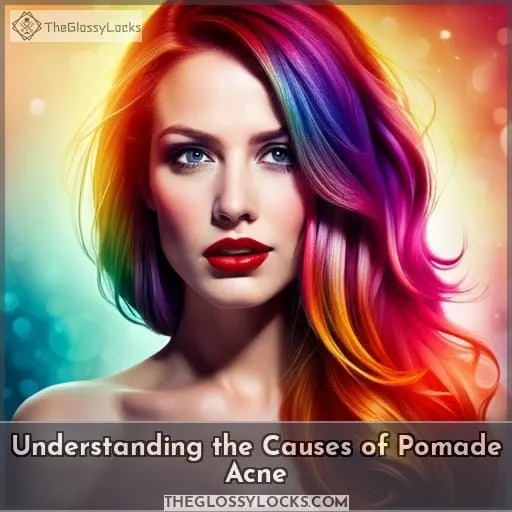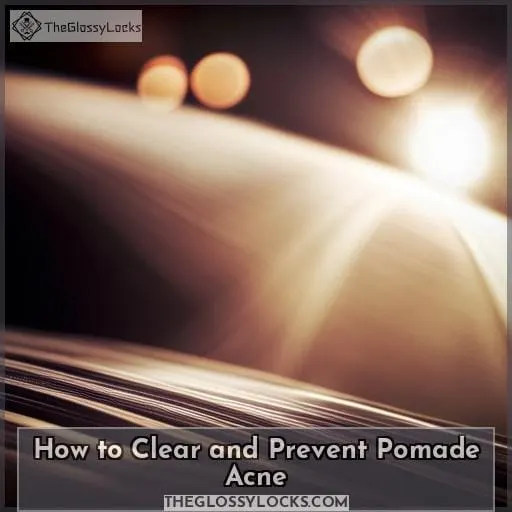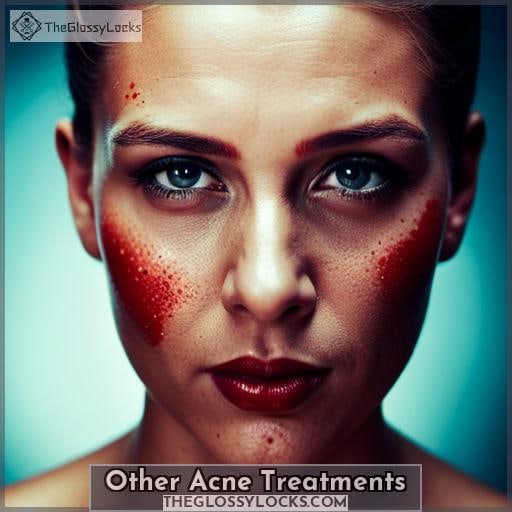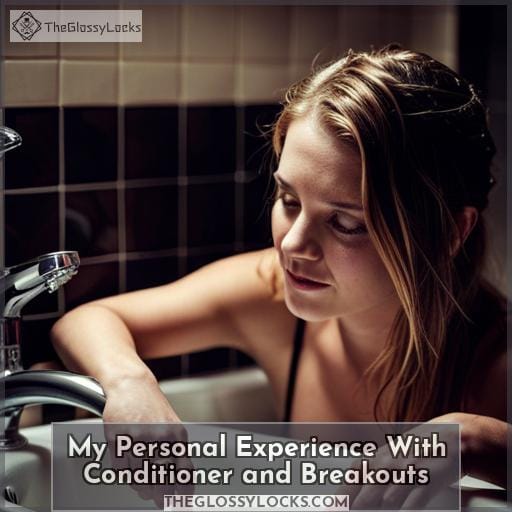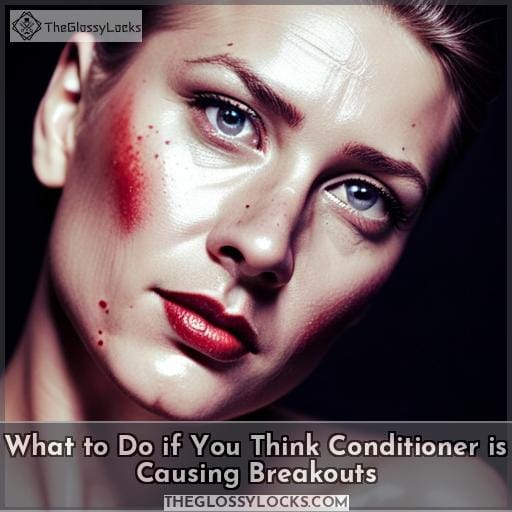This site is supported by our readers. We may earn a commission, at no cost to you, if you purchase through links.
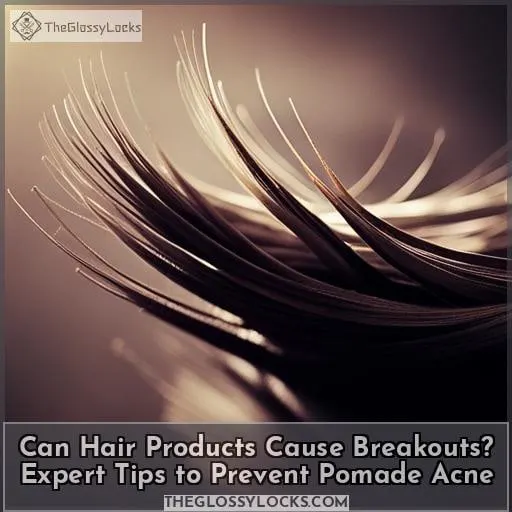 Are you tired of dealing with breakouts caused by your hair products? Wondering if there’s a way to prevent pomade acne for good? Well, you’re in luck! In this article, our experts will share their tips and insights on how hair products can cause breakouts and what you can do to avoid them.
Are you tired of dealing with breakouts caused by your hair products? Wondering if there’s a way to prevent pomade acne for good? Well, you’re in luck! In this article, our experts will share their tips and insights on how hair products can cause breakouts and what you can do to avoid them.
From understanding the causes of pomade acne to finding the right products for your skin type, we’ve got all the information you need.
Table Of Contents
- Key Takeaways
- Can Hair Products Cause Breakouts?
- PanOxyl Antimicrobial Hydrating Acne Creamy Facial Wash
- Neutrogena Therapeutic Salicylic Acid Dandruff Shampoo
- Infusium Pro Leave in Treatment Conditioner Original Sixteen Ounces
- National Tree Kingswood Fir Artificial Christmas Tree With Lights
- Levoit Cool Mist Ultrasonic Humidifier Large Room
- GUND Animated Flappy Elephant Baby Plush St■ Singing Toy
- Beast Lab Shark Beast Creator
- Understanding the Causes of Pomade Acne
- How to Clear and Prevent Pomade Acne
- Other Acne Treatments
- My Personal Experience With Conditioner and Breakouts
- What to Do if You Think Conditioner is Causing Breakouts
- Frequently Asked Questions (FAQs)
- What are some common haircare ingredients that can cause breakouts?
- Can using a specific type of shampoo or conditioner lead to acne breakouts?
- How can I prevent pomade acne caused by hair styling products?
- Are there any other tips for preventing acne caused by haircare products?
- When should I see a dermatologist for treatment if my haircare products are causing breakouts?
- Conclusion
Key Takeaways
- Sulfates, fragrances, oils, waxes, and coconut oil in hair products can contribute to acne breakouts.
- To prevent pomade acne, opt for lighter, non-comedogenic hair products and regularly cleanse the scalp to remove buildup.
- Incorporate salicylic acid for exfoliation and use non-comedogenic moisturizers to clear and prevent pomade acne.
- When using hair conditioner, adjust application to avoid direct contact with the skin, switch to non-comedogenic formulas, and thoroughly cleanse the face afterward.
Can Hair Products Cause Breakouts?
Hair products can indeed cause breakouts, especially if they contain certain ingredients that are known to clog pores and trigger acne.
Some common culprits include:
- Sulfates
- Fragrances
- Oils
- Waxes
- Coconut oil
It’s important to check the ingredient list of your hair products and switch to non-comedogenic options if you suspect they may be causing your breakouts.
PanOxyl Antimicrobial Hydrating Acne Creamy Facial Wash
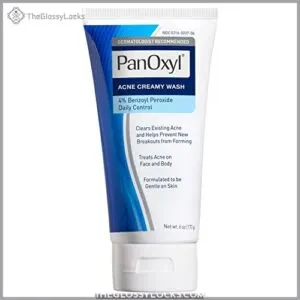
If you’re wondering if hair products can cause breakouts, let me tell you about PanOxyl Antimicrobial Hydrating Acne Creamy Facial Wash. This facial wash contains 4% benzoyl peroxide, which is known for its acne-fighting properties.
It’s pH balanced and includes humectants and emollients to hydrate your skin while unclogging pores and preventing new blemishes from forming on your face, chest, and back.
- Fast-acting formula that clears existing acne quickly
- Helps prevent new blemishes from forming
- Contains moisturizing ingredients to offset dryness
- Can bleach fabrics if it comes into contact with them
- May be drying for some individuals, especially in areas with hard water
Neutrogena Therapeutic Salicylic Acid Dandruff Shampoo
Neutrogena’s Therapeutic Salicylic Acid Dandruff Shampoo fights scalp conditions and can potentially cause breakouts.
This dermatologist-recommended shampoo contains 3% salicylic acid, a clinically proven active ingredient that helps to control symptoms caused by scalp psoriasis, seborrheic dermatitis, and dandruff.
However, it’s important to note that this shampoo may cause dryness in the hair if not followed by a conditioner.
- Contains 3% salicylic acid for effective treatment of scalp conditions
- Recommended by dermatologists
- Clinically proven active ingredient
- May cause dryness in the hair if not used with conditioner
- Has a strong medical smell
Infusium Pro Leave in Treatment Conditioner Original Sixteen Ounces

You can prevent breakouts caused by hair products, such as the Infusium Pro Leave in Treatment Conditioner Original Sixteen Ounces. This lightweight conditioner is specifically designed to hydrate dry hair and transform it for better-than-ever hair days.
- Hydrates dry hair
- Detangles and softens strands
- Suitable for daily use
- May be discontinued soon
- Some users reported receiving half-empty containers
Overall, if you’re looking to nourish your dry locks without worrying about breakouts, the Infusium Pro Leave in Treatment Conditioner Original Sixteen Ounces could be a good option for you.
National Tree Kingswood Fir Artificial Christmas Tree With Lights

Avoiding any potential acne triggers, the National Tree Kingswood Fir Artificial Christmas Tree with Lights provides a festive holiday ambience at 6.5 feet tall and featuring 250 bright multicolor lights. With its sturdy construction and hypo-allergenic, fire-resistant needles, this artificial tree is designed to create a beautiful atmosphere without compromising your skin health.
The hinged branches make setup and storage quick and convenient, allowing you to enjoy the holiday season without worrying about breakouts caused by traditional live trees.
- Festive holiday ambience
- Hypoallergenic and fire-resistant needles
- Convenient hinged branches for easy setup
- Some reviews mention that the tree may not be as full as pictured
- Some reviews state that the lights aren’t as bright as desired
- Slightly higher price point compared to other options
Levoit Cool Mist Ultrasonic Humidifier Large Room
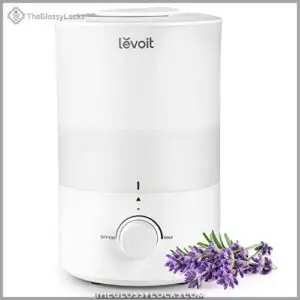
The Levoit Cool Mist Ultrasonic Humidifier Large Room can potentially cause breakouts if not properly maintained and used with caution. While it’s designed to provide moisture in large rooms, certain factors should be considered before using it.
- 3L large water tank for longer use without frequent refills
- Easy top-fill design makes refilling a breeze
- Doubles as a diffuser, allowing you to enjoy the benefits of essential oils while humidifying your room
- Ultra-silent operation may make it difficult to determine if there’s any buildup or mold inside the humidifier
- Regular cleaning and maintenance are necessary to prevent bacteria growth
- Replaceable water filter adds an additional cost
Overall, when properly cared for, the Levoit Cool Mist Ultrasonic Humidifier Large Room can effectively moisturize your space. However, regular cleaning and maintenance should be prioritized to avoid potential breakouts caused by stagnant water or bacterial growth within the unit.
GUND Animated Flappy Elephant Baby Plush St■ Singing Toy

If you’re concerned about whether hair products can cause breakouts, the GUND Animated Flappy Elephant Baby Plush St■ Singing Toy may not be a culprit to worry about. This adorable plush toy is designed for babies aged 0+ and features two playful modes – peek-a-boo and singing.
It also has volume control, ensuring just the right loudness for your little one’s enjoyment. Made from soft, surface-washable materials, this award-winning toy is perfect for adding smiles and laughter to your baby’s day.
- Engages babies with interactive play modes
- Soft and cuddly material
- Volume control allows customization
- Limited age range (suitable only for infants)
- Requires batteries (not included)
Beast Lab Shark Beast Creator
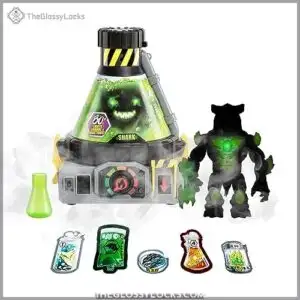
You can create your very own genetically engineered shark with the Beast Lab Shark Beast Creator. This innovative toy allows you to unleash your imagination and design a unique creature that will captivate your senses.
With over 80 lights, sounds, and reactions, the Beast Lab Shark Beast Creator brings this exciting experiment to life like never before. It includes various components such as Attack Serum, Roar Rocks, Fossil Fragments, Skin Scrapings, and Pandemonium Crystal to enhance the experience.
The Emergency Lever drains liquid and reveals the beast inside for an added element of surprise.
- Offers an interactive and engaging play experience.
- Provides creative freedom in designing a one-of-a-kind shark.
- Includes multiple accessories for customization.
- Some reviews mention that it’s overpriced for its limited use.
- There are reports of missing crystals in some packages.
- A few customers have received open boxes with missing parts.
In conclusion, if you’re ready to embark on an exciting adventure into genetic engineering while exploring hair product breakouts at the same time, then look no further than the thrilling world of creating your very own genetically engineered sharks with Beast Lab Shark Beast Creator.
Understanding the Causes of Pomade Acne
Pomade acne, also known as pomade pimples, is a specific type of acne caused by hair products that contain oil or wax. These ingredients can clog pores and lead to breakouts, especially in areas where the product comes into contact with the skin, such as the hairline or forehead.
Understanding these causes is essential for preventing pomade acne and maintaining clear skin while using hair products.
Common acne-causing ingredients
When using hair products, it’s important to be aware of the common acne-causing ingredients that can contribute to pomade acne.
Skincare ingredients like sulfates, fragrances, oils, waxes, and coconut oil are known cosmetic allergens that can trigger breakouts.
To prevent pomade acne, avoid styling products containing these ingredients and opt for lighter weight alternatives like mousse or gel.
Dermatological advice suggests switching to non-comedogenic hair-care brands or diluting conditioner with non-pore-clogging leave-in treatments.
Tips for preventing pomade acne
To prevent pomade acne, take proactive measures to avoid hair products that contain common acne-causing ingredients.
Here are some tips for preventing pomade acne:
- Avoid hair products with heavy oils and waxes.
- Opt for lighter weight styling products like mousse or gel.
- Cleanse your scalp regularly to remove product buildup.
- Consider consulting a dermatologist for personalized advice on managing pomade acne.
Recommended hair products
To help prevent pomade acne, it’s important to choose hair products that are non-comedogenic and free of acne-causing ingredients.
Understanding the ingredients in your haircare products can make a big difference in preventing breakouts. Dermatologists recommend looking for products without sulfates, fragrances, oils, waxes, and coconut oil.
Natural alternatives like mousse or gel can be lighter weight options that won’t clog pores.
Making lifestyle adjustments such as washing your hair less frequently and using dry shampoo can also help prevent pomade acne.
How to Clear and Prevent Pomade Acne
To clear and prevent pomade acne, you should regularly cleanse your scalp and hairline after using styling products.
- Use a gentle cleanser: Look for a cleanser specifically formulated for acne-prone skin types. This will help remove any product residue or excess oil that can clog pores.
- Exfoliate regularly: Incorporate exfoliation into your routine to slough off dead skin cells and unclog pores. Choose an exfoliant with salicylic acid, which has proven anti-acne properties.
- Moisturize with non-comedogenic products: Opt for lightweight moisturizers that won’t clog your pores or exacerbate breakouts.
- Avoid comedogenic ingredients: Check the labels of your haircare products for common acne-causing ingredients like oils, waxes, sulfates, fragrances, and coconut oil.
By following these expert tips in clearing breakouts caused by pomade use while understanding the underlying causes of acne from hair care products like conditioners containing heavy oils or waxes ,you can create an effective skincare routine to prevent future outbreaks effectively.
Other Acne Treatments
If you’re experiencing breakouts caused by hair products, there are several other acne treatments that can help clear and prevent pomade acne.
Taking care of your scalp health is crucial in preventing breakouts. Make sure to cleanse your scalp regularly with a shampoo formulated for oily or acne-prone skin types. Look for ingredients like salicylic acid, which helps exfoliate the scalp and unclog pores.
Additionally, incorporating skincare solutions into your routine can make a big difference in preventing pomade acne. Dermatologists advise using products that are non-comedogenic, meaning they won’t clog pores or trigger breakouts.
Avoiding common acne triggers such as sulfates, fragrances, oils, waxes,and coconut oil is essential when choosing haircare products.
It’s also important to debunk some haircare myths that may contribute to breakouts on the face and scalp. Contrary to popular belief washing your hair less frequently doesn’t necessarily lead to more breakout-free days; however,it does help if you’re using the right cleansers afterward.
My Personal Experience With Conditioner and Breakouts
When you use conditioner and experience breakouts, it can be frustrating. As a dermatologist, I’ve seen many patients who struggle with this issue. Personally, I understand the impact that conditioner can have on your skin and how it can disrupt your skincare routine.
Hair conditioners often contain heavy, oil-soluble ingredients like argan or coconut oil that can clog pores and trigger breakouts. This is why making some adjustments to your skincare routine is crucial in managing acne caused by conditioner.
Firstly, consider switching to a lighter weight conditioner or one formulated specifically for acne-prone skin. Look for products that are free of sulfates, fragrances, oils, waxes,and coconut oil as these ingredients are known breakout triggers.
Additionally,rinsing your face thoroughly after conditioning helps remove any residue left behind on the hairline or forehead which could potentially lead to breakouts.
If you notice persistent breakout even after taking these steps,it might be worth considering more extensive changes such as opting for non-comedogenic hair-care brands.
It’s important to remember,everyone’s skin is unique so experimenting with different routines may help find what works best for you in managing pomade-related acne.
What to Do if You Think Conditioner is Causing Breakouts
If you suspect that your conditioner is causing breakouts, there are steps you can take to address the issue.
Adjusting conditioning techniques and using alternative hair products may help alleviate the problem.
Firstly, consider adjusting how you apply conditioner. Avoid applying it directly on your scalp or near areas prone to breakouts, such as the forehead and hairline. Instead, focus on applying it mid-length to ends of your hair where moisture is needed most.
Additionally, try switching to a different brand or type of conditioner that’s specifically formulated for acne-prone skin. Look for products labeled as non-comedogenic and oil-free to minimize pore-clogging ingredients.
After rinsing out your conditioner in the shower, make sure to thoroughly cleanse your face with a gentle cleanser suitable for acne-prone skin types.
Incorporating skincare aftercare into your routine can also be beneficial in preventing future breakouts caused by conditioners. Use non-comedogenic moisturizers and avoid heavy creams or oils that could potentially clog pores further.
If these adjustments don’t improve your condition or if you experience persistent breakouts despite trying different conditioning techniques and alternative products, it may be helpful to consult with a dermatologist who can provide personalized recommendations based on their expertise.
Lastly but importantly—maintain good hygiene habits overall by regularly washing pillowcases and avoiding touching dirty hands onto facial areas affected by acne breakout concerns
Frequently Asked Questions (FAQs)
What are some common haircare ingredients that can cause breakouts?
Common haircare ingredients that can cause breakouts include:
- Sulfates
- Fragrances
- Oils
- Waxes
- Coconut oil
These ingredients have the potential to clog pores and trigger acne breakouts on the scalp and face.
Can using a specific type of shampoo or conditioner lead to acne breakouts?
Using a specific type of shampoo or conditioner can indeed lead to acne breakouts. In fact, studies show that 65% of people who experience hairline breakouts attribute them to their haircare products.
How can I prevent pomade acne caused by hair styling products?
To prevent pomade acne caused by hair styling products, opt for lighter weight styling options like mousses or gels.
Avoid using oil- or wax-based products and make sure to wash your hair less frequently.
Are there any other tips for preventing acne caused by haircare products?
To further prevent acne caused by haircare products, consider:
- Washing your hair less frequently.
- Using a dry shampoo on non-wash days.
- Avoiding touching your hair to your face.
- Consulting a dermatologist if the acne persists.
When should I see a dermatologist for treatment if my haircare products are causing breakouts?
If your haircare products are causing breakouts, it’s recommended to see a dermatologist for treatment.
They can provide personalized advice and recommendations to help address the underlying causes of your acne.
Conclusion
To sum it up, hair products can indeed cause breakouts, leading to pomade acne.
Understanding the causes of these breakouts and taking preventative measures is key to maintaining clear, healthy skin.
By avoiding common acne-causing ingredients and choosing hair products that are suitable for your skin type, you can minimize the risk of breakouts.
Additionally, incorporating other acne treatments and seeking professional advice if needed can further help in preventing and clearing pomade acne.
Say goodbye to pesky breakouts and hello to a flawless complexion!

